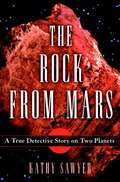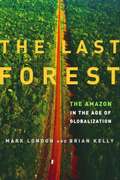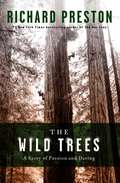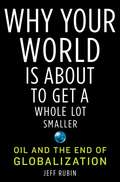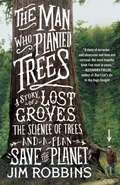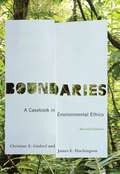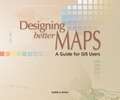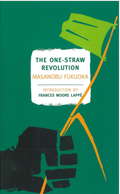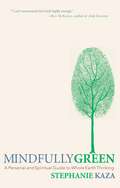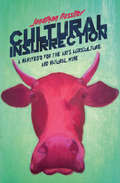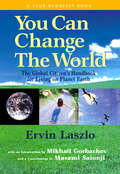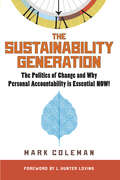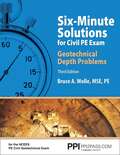- Table View
- List View
The Rock From Mars
by Kathy SawyerIn this riveting book, acclaimed journalist Kathy Sawyer reveals the deepest mysteries of space and some of the most disturbing truths on Earth. The Rock from Mars is the story of how two planets and the spheres of politics and science all collided at the end of the twentieth century. It began sixteen million years ago. An asteroid crashing into Mars sent fragments flying into space and, eons later, one was pulled by the Earth’s gravity onto an icy wilderness near the southern pole. There, in 1984, a...
The Last Forest: The Amazon in the Age of Globalization
by Mark London Brian KellyWith a landmass larger than the continental U. S. west of the Mississippi and the richest diversity of plant and animal species on earth, the Amazon has always struck its explorers and would-be exploiters as infinite and largely impenetrable. For decades, anthropologists assumed that permanent human habitation was impossible–-but they were wrong. Recently, proof of centuries-old Amazonian civilizations has been unearthed, shifting perceptions of the inhospitability of the rain forest and providing a precedent for human occupation. Today, as developers and environmentalists clash over the region’s future, the seemingly endless forest is fast disappearing in fires, rampant mineral extraction, rogue logging operations, and encroaching urban sprawl. Through a series of startling human encounters–interviews with government ministers and environmental crusaders, millionaire ranchers and disenfranchised slum dwellers–Mark London and Brian Kelly, longtime explorers and trailblazing chroniclers of the Amazon basin, trace the region’s transformation. Logging thousands of miles, London and Kelly take readers from the mushrooming shopping malls of Manaus to the pristine rain forest that still seems beyond the reach of civilization, from the ghostly ruins of abandoned factories and failed plantations to the thriving agribusinesses that one day may feed the entire world and change this landscape forever. Again and again, they collide with the same fundamental question: Is it too late to strike a balance in the Amazon between economic sustenance for the twenty-one million Brazilians who live there and protection for the world’s last great forest? London and Brian Kelly have fashioned a complex, vibrant portrait of a region on the edge of crisis. At once a seductive journey and a searing account of political, environmental, and social tumult, The Last Forest is a masterpiece of contemporary reporting.
The Wild Trees: A Story of Passion and Daring
by Richard PrestonHidden away in foggy, uncharted rain forest valleys in Northern California are the largest and tallest organisms the world has ever sustained–the coast redwood trees, Sequoia sempervirens. Ninety-six percent of the ancient redwood forests have been destroyed by logging, but the untouched fragments that remain are among the great wonders of nature. The biggest redwoods have trunks up to thirty feet wide and can rise more than thirty-five stories above the ground, forming cathedral-like structures in the air. Until recently, redwoods were thought to be virtually impossible to ascend, and the canopy at the tops of these majestic trees was undiscovered. In The Wild Trees, Richard Preston unfolds the spellbinding story of Steve Sillett, Marie Antoine, and the tiny group of daring botanists and amateur naturalists that found a lost world above California, a world that is dangerous, hauntingly beautiful, and unexplored. The canopy voyagers are young–just college students when they start their quest–and they share a passion for these trees, persevering in spite of sometimes crushing personal obstacles and failings. They take big risks, they ignore common wisdom (such as the notion that there’s nothing left to discover in North America), and they even make love in hammocks stretched between branches three hundred feet in the air. The deep redwood canopy is a vertical Eden filled with mosses, lichens, spotted salamanders, hanging gardens of ferns, and thickets of huckleberry bushes, all growing out of massive trunk systems that have fused and formed flying buttresses, sometimes carved into blackened chambers, hollowed out by fire, called “fire caves.” Thick layers of soil sitting on limbs harbor animal and plant life that is unknown to science. Humans move through the deep canopy suspended on ropes, far out of sight of the ground, knowing that the price of a small mistake can be a plunge to one’s death. Preston’s account of this amazing world, by turns terrifying, moving, and fascinating, is an adventure story told in novelistic detail by a master of nonfiction narrative. The author shares his protagonists’ passion for tall trees, and he mastered the techniques of tall-tree climbing to tell the story in The Wild Trees–-the story of the fate of the world’s most splendid forests and of the imperiled biosphere itself.
The Wild Trees: A Story of Passion and Daring
by Richard PrestonHidden away in foggy, uncharted rain forest valleys in Northern California are the largest and tallest organisms the world has ever sustained-the coast redwood trees, Sequoia sempervirens. Ninety-six percent of the ancient redwood forests have been destroyed by logging, but the untouched fragments that remain are among the great wonders of nature. The biggest redwoods have trunks up to thirty feet wide and can rise more than thirty-five stories above the ground, forming cathedral-like structures in the air. Until recently, redwoods were thought to be virtually impossible to ascend, and the canopy at the tops of these majestic trees was undiscovered. In The Wild Trees, Richard Preston unfolds the spellbinding story of Steve Sillett, Marie Antoine, and the tiny group of daring botanists and amateur naturalists that found a lost world above California, a world that is dangerous, hauntingly beautiful, and unexplored. The canopy voyagers are young-just college students when they start their quest-and they share a passion for these trees, persevering in spite of sometimes crushing personal obstacles and failings. They take big risks, they ignore common wisdom (such as the notion that there's nothing left to discover in North America), and they even make love in hammocks stretched between branches three hundred feet in the air.The deep redwood canopy is a vertical Eden filled with mosses, lichens, spotted salamanders, hanging gardens of ferns, and thickets of huckleberry bushes, all growing out of massive trunk systems that have fused and formed flying buttresses, sometimes carved into blackened chambers, hollowed out by fire, called "fire caves." Thick layers of soil sitting on limbs harbor animal and plant life that is unknown to science. Humans move through the deep canopy suspended on ropes, far out of sight of the ground, knowing that the price of a small mistake can be a plunge to one's death.Preston's account of this amazing world, by turns terrifying, moving, and fascinating, is an adventure story told in novelistic detail by a master of nonfiction narrative. The author shares his protagonists' passion for tall trees, and he mastered the techniques of tall-tree climbing to tell the story in The Wild Trees-the story of the fate of the world's most splendid forests and of the imperiled biosphere itself.From the Hardcover edition.
The Wild Trees: A Story of Passion and Daring
by Richard PrestonHidden away in foggy, uncharted rain forest valleys in Northern California are the largest and tallest organisms the world has ever sustained-the coast redwood trees, Sequoia sempervirens. Ninety-six percent of the ancient redwood forests have been destroyed by logging, but the untouched fragments that remain are among the great wonders of nature. The biggest redwoods have trunks up to thirty feet wide and can rise more than thirty-five stories above the ground, forming cathedral-like structures in the air. Until recently, redwoods were thought to be virtually impossible to ascend, and the canopy at the tops of these majestic trees was undiscovered. In The Wild Trees, Richard Preston unfolds the spellbinding story of Steve Sillett, Marie Antoine, and the tiny group of daring botanists and amateur naturalists that found a lost world above California, a world that is dangerous, hauntingly beautiful, and unexplored. The canopy voyagers are young-just college students when they start their quest-and they share a passion for these trees, persevering in spite of sometimes crushing personal obstacles and failings. They take big risks, they ignore common wisdom (such as the notion that there's nothing left to discover in North America), and they even make love in hammocks stretched between branches three hundred feet in the air.The deep redwood canopy is a vertical Eden filled with mosses, lichens, spotted salamanders, hanging gardens of ferns, and thickets of huckleberry bushes, all growing out of massive trunk systems that have fused and formed flying buttresses, sometimes carved into blackened chambers, hollowed out by fire, called "fire caves." Thick layers of soil sitting on limbs harbor animal and plant life that is unknown to science. Humans move through the deep canopy suspended on ropes, far out of sight of the ground, knowing that the price of a small mistake can be a plunge to one's death.Preston's account of this amazing world, by turns terrifying, moving, and fascinating, is an adventure story told in novelistic detail by a master of nonfiction narrative. The author shares his protagonists' passion for tall trees, and he mastered the techniques of tall-tree climbing to tell the story in The Wild Trees-the story of the fate of the world's most splendid forests and of the imperiled biosphere itself.From the Hardcover edition.
Worlds at War: The 2,500-Year Struggle Between East and West
by Anthony PagdenSpanning two and a half millennia, Anthony Pagden's mesmerizing Worlds at War delves deep into the roots of the "clash of civilizations" between East and West that has always been a battle over ideas, and whose issues have never been more urgent.Worlds At War begins in the ancient world, where Greece saw its fight against the Persian Empire as one between freedom and slavery, between monarchy and democracy, between individuality and the worship of men as gods. Here, richly rendered, are the crucial battle of Marathon, considered the turning point of Greek and European history; the heroic attempt by the Greeks to turn the Persians back at Thermopylae; and Salamis, one of the greatest naval battles of all time, which put an end to the Persian threat forever.From there Pagden's story sweeps to Rome, which created the modern concepts of citizenship and the rule of law. Rome's leaders believed those they conquered to be free, while the various peoples of the East persisted in seeing their subjects as property. Pagden dramatizes the birth of Christianity in the East and its use in the West as an instrument of government, setting the stage for what would become, and has remained, a global battle of the secular against the sacred. Then Islam, at first ridiculed in Christian Europe, drives Pope Urban II to launch the Crusades, which transform the relationship between East and West into one of competing religious beliefs.Modern times bring a first world war, which among its many murky aims seeks to redesign the Muslim world by force. In our own era, Muslims now find themselves in unwelcoming Western societies, while the West seeks to enforce democracy and its own secular values through occupation in the East. Pagden ends on a cautionary note, warning that terrorism and war will continue as long as sacred and secular remain confused in the minds of so many.Eye-opening and compulsively readable, Worlds at War is a stunning work of history and a triumph of modern scholarship. It is bound to become the definitive work on the reasons behind the age-old and still escalating struggle that, more than any other, has come to define the modern world-a book for anyone seeking to know why "we came to be the way we are."From the Hardcover edition.
Why Your World Is About To Get A Whole Lot Smaller: Oil and the End of Globalization
by Jeff RubinWhat do subprime mortgages, Atlantic salmon dinners, SUVs and globalization have in common? They all depend on cheap oil. And in a world of dwindling oil supplies and steadily mounting demand around the world, there is no such thing as cheap oil. Oil might be less expensive in the middle of a recession, but it will never be cheap again. Take away cheap oil, and the global economy is getting the shock of its life. From the ageing oilfields of Saudi Arabia and the United States to the Canadian tar sands, from the shopping malls of Dubai to the shuttered auto plants of North America and Europe, from the made-in-China products on the shelves of the Wal-Mart down the road to the collapse of Wall Street giants, everything is connected to the price of oil Interest rates, carbon trading, inflation, farmers’ markets and the wave of trade protectionism washing up all over the world in the wake of various economic stimulus and bailout packages – they all hinge on the new realities of a world where demand for oil eventually outstrips supply. According to maverick economist Jeff Rubin, there will be no energy bailout. The global economy has suffered oil crises in the past, but this time around the rules have changed. And that means the future is not going to be a continuation of the past. For generations we have built wealth by burning more and more oil. Our cars, our homes, our whole world has been getting bigger in the cheap-oil era. Now it is about to get smaller. There will be winners as well as losers as the age of globalization comes to an end. The auto industry will never recover from this oil-induced recession, but other manufacturers will be opening up mothballed factories. Distance will soon cost money, and so will burning carbon – both will bring long-lost jobs back home. We may not see the kind of economic growth that globalization has brought, but local economies will be revitalized, as will our cities and neighborhoods. Whether we like it or not, our world is about to get a whole lot smaller. From the Hardcover edition.
The Man Who Planted Trees: A Story of Lost Groves, the Science of Trees, and a Plan to Save the Planet
by Jim RobbinsTHIS BOOK JUST MIGHT SAVE THE PLANET "When is the best time to plant a tree? Twenty years ago. The second best time? Today."--Chinese proverb Twenty years ago, David Milarch, a northern Michigan nurseryman with a penchant for hard living, had a vision: angels came to tell him that the earth was in trouble. Its trees were dying, and without them, human life was in jeopardy. The solution, they told him, was to clone the champion trees of the world--the largest, the hardiest, the ones that had survived millennia and were most resilient to climate change--and create a kind of Noah's ark of tree genetics. Without knowing if the message had any basis in science, or why he'd been chosen for this task, Milarch began his mission of cloning the world's great trees. Many scientists and tree experts told him it couldn't be done, but, twenty years later, his team has successfully cloned some of the world's oldest trees--among them giant redwoods and sequoias. They have also grown seedlings from the oldest tree in the world, the bristlecone pine Methuselah. When New York Times journalist Jim Robbins came upon Milarch's story, he was fascinated but had his doubts. Yet over several years, listening to Milarch and talking to scientists, he came to realize that there is so much we do not yet know about trees: how they die, how they communicate, the myriad crucial ways they filter water and air and otherwise support life on Earth. It became clear that as the planet changes, trees and forest are essential to assuring its survival. The Man Who Planted Trees is both a fascinating investigation into the world of trees and the inspiring story of one man's quest to help save the planet. This book's hopeful message of what one man can accomplish against all odds is also a lesson about how each of us has the ability to make a difference. This book was printed in the United States of America on Rolland EnviroTM 100 Book, which is manufactured using FSC-certified 100% postconsumer fiber and meets permanent paper standards.From the Hardcover edition.
Focus On Earth Science
by James Sammons Mary Beth Abel Hughes Patsy Eldridge Lynda PennellNIMAC-sourced textbook
Focus on Earth Science
by Cpo ScienceContains comprehensive content that introduces your students to key earth science concepts including energy, plate tectonics, weathering, earthquakes, volcanoes, and ecosystems. The text also integrates important ideas in science such as heat, density and buoyancy.
Earth Science
by James Sammons Mary Beth Abel Hughes Scott EddlemanEarth science includes the studies of geology, meteorology, astronomy, and oceanography. Each field involves scientists and engineers using math and technology to answer scientific questions and solve problems.
Boundaries: A Casebook in Environmental Ethics
by Christine E. Gudorf James Edward HuchingsonIn this expanded and revised edition of a fresh and original case-study textbook on environmental ethics, Christine Gudorf and James Huchingson continue to explore the line that separates the current state of the environment from what it should be in the future. <p> Boundaries begins with a lucid overview of the field, highlighting the key developments and theories in the environmental movement. Specific cases offer a rich and diverse range of situations from around the globe, from saving the forests of Java and the use of pesticides in developing countries to restoring degraded ecosystems in Nebraska. With an emphasis on the concrete circumstances of particular localities, the studies continue to focus on the dilemmas and struggles of individuals and communities who face daunting decisions with serious consequences. This second edition features extensive updates and revisions, along with four new cases: one on water privatization, one on governmental efforts to mitigate global climate change, and two on the obstacles that teachers of environmental ethics encounter in the classroom. Boundaries also includes an appendix for teachers that describes how to use the cases in the classroom.
Designing Better Maps: A Guide For GIS Users
by Cynthia A. BrewerDescribing how to build balanced map layouts suited to varied mapping goals, this guide focuses on export options that suit different media and can be edited in other applications. The wide range of text characteristics needed for expert map design as well as how to improve map readability with type effects such as character spacing, leading, callouts, shadows, and halos is detailed. Tips are included for using font tools in the Windows operating system, such as creating special characters in map text, as is information on using text characteristics to indicate feature locations, categories, and hierarchies on maps. How cartographic conventions guide placement of labels for point, line, and area features are also explained.
Georgia: What's So Great About This State?
by Kate Boehm JeromeWHY does the land in the Okefenokee Swamp seems to move? WHAT threatened the entire Georgia cotton business in the early 1920s? Find these answers and more in the Georgia edition of What's So Great About This State?
The One-Straw Revolution: An Introduction to Natural Farming (New York Review Books Classics)
by Wendell Berry Frances Moore Lappe Larry Korn Masanobu FukuokaCall it "Zen and the Art of Farming" or a "Little Green Book," Masanobu Fukuoka's manifesto about farming, eating, and the limits of human knowledge presents a radical challenge to the global systems we rely on for our food. At the same time, it is a spiritual memoir of a man whose innovative system of cultivating the earth reflects a deep faith in the wholeness and balance of the natural world. As Wendell Berry writes in his preface, the book "is valuable to us because it is at once practical and philosophical. It is an inspiring, necessary book about agriculture because it is not just about agriculture." Trained as a scientist, Fukuoka rejected both modern agribusiness and centuries of agricultural practice, deciding instead that the best forms of cultivation mirror nature's own laws. Over the next three decades he perfected his so-called "do-nothing" technique: commonsense, sustainable practices that all but eliminate the use of pesticides, fertilizer, tillage, and perhaps most significantly, wasteful effort.Whether you're a guerrilla gardener or a kitchen gardener, dedicated to slow food or simply looking to live a healthier life, you will find something here--you may even be moved to start a revolution of your own.
Mindfully Green: A Personal and Spiritual Guide to Whole Earth Thinking
by Stephanie KazaWith all the attention on living sustainably, the one thing missing from the conversation is how to find a personal connection with green living that will sustain us on our green path. While practical approaches to an eco-responsible lifestyle offer important first steps, it is critical that we ground these actions in broader understanding so that we can effect real change in the world. In this book, Stephanie Kaza describes what she calls the "green practice path. " She offers a simple, Buddhist-inspired philosophy for taking up environmental action in real, practical, and effective ways. Discover new ways to think more deeply about your impact on the natural world, engage in environmental change, and make green living a personal practice based in compassion and true conviction.
Cultural Insurrection: A Manifesto for Arts, Agriculture, and Natural Wine
by Jonathan NossiterFrom the director of Mondovino, a lively discussion of the expanding world of natural wine that considers the movement as a potential remedy for our current cultural crisis. What if, ten years from now, an artist--a filmmaker, for example--will have become as marginal and anachronistic as a blacksmith? What if the actors in the cultural world are on the brink of extinction, not about to disappear like prehistoric animals, but worse--submitting to the status quo? Absorbed by a marketplace that increasingly devalues true artistic work?In Cultural Insurrection, award-winning filmmaker and sommelier Jonathan Nossiter considers these questions and offers a solution inspired by the rebellious, innovative figures transforming the way we produce and consume wine. This new generation of artisans, working closely with the earth to create exceptional natural wines, has assumed the role of dissenters that artists have abandoned, and we should look to them in order to revitalize contemporary art.
Camping with the President
by Ginger WadsworthShows how, while on a camping trip in 1903 with world-famous naturalist John Muir in Yosemite National Park, President Theodore Roosevelt formed his position on conservation, deciding to set aside new national parks and monuments to preserve wilderness lands for future generations.
You Can Change The World
by Ervin LaszloYou Can Change the World: The Global Citizen's Handbook for Living on Planet Earth should be required reading for anyone who cares about the future of the planet. Written by renowned scientist, futurist and Club of Budapest founder Ervin Laszlo, You Can Change the World answers two pertinent questions-first, what is at the root of all the conflict and crisis in today's world? And second, what can actually be done to move toward a world where we can live in peace, without marginalizing and killing each other and destroying the environment?A handbook that urges readers to become global citizens who aspire to live responsibly on this precious but highly exploited and crisis-prone planet, You Can Change the World provides a simple and basic message: in today's world it is neither wealth nor power, nor the control of territory and technology that make the crucial difference. How we think and act shapes our present and decides our future.
You Can Change the World: The Global Citizen's Handbook for Living on Planet Earth
by Ervin Laszlo Mikhail Gorbachev Masami SaionjiYou Can Change the World: The Global Citizen's Handbook for Living on Planet Earth should be required reading for anyone who cares about the future of the planet. Written by renowned scientist, futurist and Club of Budapest founder Ervin Laszlo, You Can Change the World answers two pertinent questions-first, what is at the root of all the conflict and crisis in today's world? And second, what can actually be done to move toward a world where we can live in peace, without marginalizing and killing each other and destroying the environment?A handbook that urges readers to become global citizens who aspire to live responsibly on this precious but highly exploited and crisis-prone planet, You Can Change the World provides a simple and basic message: in today's world it is neither wealth nor power, nor the control of territory and technology that make the crucial difference. How we think and act shapes our present and decides our future.
The Sustainability Generation
by Mark C. ColemanLife on Earth is increasingly at risk. What to do about rescuing our planet, and ourselves, is a growing concern for people of all ages and all walks of life. Mark C. Coleman's groundbreaking book, The Sustainability Generation: The Politics of Change and Why Personal Accountability is Essential NOW! takes a cold, hard look at the facts about where we stand and how to move forward. The Sustainability Generation is beyond simply another "green" book in that it focuses on the poisonous influence of our acquisitive culture and its root cause --entitlement. Our culture of entitlement encourages the belief that instant gratification is our right; this in turn erodes our sense of duty toward anything outside of these immediate desires. Our consumption habits are out of control and they are sabotaging our destiny. In response to this, Mr. Coleman argues that nurturing our sense of personal responsibility, and squashing our hunger for more "stuff" is the single most important step toward saving our world for future generations. The "Baby Boomer" generation is retiring and the so-called "Generation Y" will soon receive the largest transfer of wealth in history. It is vital to emphasize the need for replacing our entitlement culture with sustainable growth through redefining our core values. The Sustainability Generation provides a clear roadmap of how individuals can empower and enlighten themselves and their peers. A new "Sustainability Generation" that is committed to environmental and social change will offer the promise of the greatest legacy possible--a future!
PPI California Civil Seismic Building Design, 12th Edition eText - 1 Year
by Michael R. Lindeburg PEComprehensive Guide on Seismic Design for the California Civil Seismic Principles ExamCalifornia Civil Seismic Building Design, 12th Edition presents the seismic design concepts most essential to engineers, architects, and students of civil and structural engineering and architecture. The book&’s 15 chapters provide a concise but thorough review of seismic theory, code application, design principles, and structural analysis.Topics CoveredBasic SeismologyDetails of Seismic-Resistant Structures (Concrete, Masonry, Steel, Wood)Diaphragm TheoryEarthquake CharacteristicsEffects of Earthquakes on StructuresGeneral Structural DesignResponse of StructuresSeismic Building CodeSpecial Design FeaturesTilt-Up ConstructionVibration TheoryReferenced Codes and StandardsAISC 341AISC 360ACI 318ACI 530NDSSDPWDASCE/SEI7IBCKey Features30 example problems demonstrate how to apply concepts, codes, and equations to solve realistic problemsMore than 125 practice problems provide opportunities for independent problem-solving practice, and complete solutions allow you to check your solution approachTwo comprehensive indexes—one of key terms and another of seismic building codes—to quickly direct you to the information you are looking forReferences throughout the text to the 150 equations, 29 tables, 144 figures, and 21 appendices, and to relevant codes and standardsBinding: PaperbackPublisher: PPI, A Kaplan Company
PPI Six-Minute Solutions for Civil PE Exam Geotechnical Depth Problems, 3rd Edition eText - 1 Year
by Bruce A. Wolle MSE, PETargeted Training for Solving Civil PE Exam Geotechnical Depth Multiple-Choice ProblemsSix-Minute Solutions for Civil PE Exam Geotechnical Depth Problems contains 102 multiple-choice problems that are grouped into ten chapters. Each chapter corresponds to a topic on the NCEES PE Civil exam geotechnical depth section. Like the PE exam, an average of six minutes is required to solve each problem in this book. Each problem also includes a hint that provides optional problem-solving guidance.Topics CoveredDeep FoundationsEarth Retaining StructuresEarth StructuresEarthquake Engineering and Dynamic LoadsField Materials Testing, Methods, and SafetyGroundwater and SeepageProblematic Soil and Rock ConditionsShallow FoundationsSite CharacterizationSoil Mechanics, Lab Testing, and AnalysisReferenced Design StandardsMinimum Design Loads for Buildings and Other Structures (ASCE 7)Safety and Health Regulations for Construction (OSHA 29 CFR Part 1926)Key FeaturesProblems are representative of the exam&’s format, scope of topics, and level of difficulty.Connect relevant theory to exam-like problems.Comprehensive step-by-step solutions for all problems demonstrate accurate and efficient solving approaches.Organize the codes and references you will use on exam day.Binding: PaperbackPublisher: PPI, A Kaplan Company
